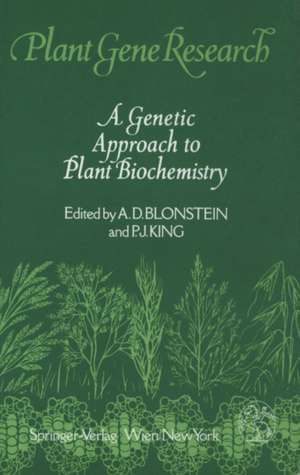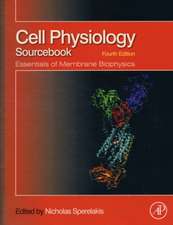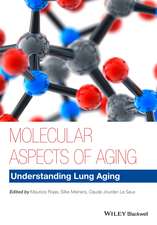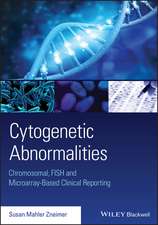A Genetic Approach to Plant Biochemistry: Plant Gene Research
Editat de A. D. Blonstein, P. J. Kingen Limba Engleză Paperback – oct 2011
Preț: 393.74 lei
Nou
Puncte Express: 591
Preț estimativ în valută:
75.34€ • 78.67$ • 62.21£
75.34€ • 78.67$ • 62.21£
Carte tipărită la comandă
Livrare economică 15-29 aprilie
Preluare comenzi: 021 569.72.76
Specificații
ISBN-13: 9783709174630
ISBN-10: 3709174635
Pagini: 312
Ilustrații: XII, 296 p.
Dimensiuni: 178 x 254 x 16 mm
Greutate: 0.55 kg
Ediția:Softcover reprint of the original 1st ed. 1986
Editura: SPRINGER VIENNA
Colecția Springer
Seria Plant Gene Research
Locul publicării:Vienna, Austria
ISBN-10: 3709174635
Pagini: 312
Ilustrații: XII, 296 p.
Dimensiuni: 178 x 254 x 16 mm
Greutate: 0.55 kg
Ediția:Softcover reprint of the original 1st ed. 1986
Editura: SPRINGER VIENNA
Colecția Springer
Seria Plant Gene Research
Locul publicării:Vienna, Austria
Public țintă
ResearchCuprins
1 Gibberellin Mutants.- I. Introduction.- II. Selection and Identification of Mutants.- III. GA Synthesis.- IV. Internode Length.- V. Seed Dormancy.- VI. Flowering and Senescence.- VII. Site of Action of GA Mutants.- VIII. Conclusions.- IX. References.- 2 Genetic Aspects of Abscisic Acid.- I. Introduction.- II. ABA-Deficient Mutants.- III. Mutants Affecting ABA Sensitivity.- IV. Genetic Differences in ABA Accumulation.- V. Conclusions.- VI. References.- 3 Mutants as Tools for the Elucidation of Photosynthetic Processes.- I. Introduction.- II. Two Genomes Code for the Structural and Regulatory Elements of the Photosynthetic Apparatus.- III. Identification of Thylakoid Membrane Proteins and Their Functions.- IV. From Phenotype to Gene Structure.- V. Conclusions.- VI. References.- 4 Maize Alcohol Dehydrogenase: A Molecular Perspective.- I. Introduction.- II. Genetics and Expression of ADH Enzymes in Maize.- III. Isolation of Adh Genes.- IV. Structure of Plant Adh Genes.- V. Three-Dimensional Structure of ADH Enzymes.- VI. Genetic Change Around and Within Adh Genes of Maize.- VII. Approaches to the Mechanism of Adh Gene Regulation.- VIII. In Vivo Expression of Adh.- IX. Conclusions.- X. References.- 5 The Molecular Genetics of Higher Plant Nitrate Assimilation.- I. Introduction.- II. The Nitrate Assimilation Pathway.- III. Genetics of Nitrate Assimilation.- IV. Applied Aspects.- V. References.- 6 Plant Genetic Approaches to Symbiotic Nodulation and Nitrogen Fixation in Legumes.- I. Introduction.- II. A General Description of Legume Nodule Ontogeny.- III. The Parasponia-Bradyrhizobium Symbiosis.- IV. Biochemical and Molecular Analysis of Plant Functions.- V. Gene-for-Gene Aspects of Nodulation.- VI. Existing Plant Variation in Symbiotic Nitrogen Fixation.- VII Existing Single Locus Variation for Nodulation-Nitrogen Fixation.- VIII. Induced Mutation in Symbiotic Characters.- IX. Conclusions.- X. References.- 7 Endosperm Proteins.- I. Introduction.- II. Origin and Development of the Endosperm.- III. Classification of the Major Endosperm Proteins.- IV. Biochemical Complexity and Genetic Variation of Endosperm Proteins.- V. Gene Mutations.- VI. Chromosome Mutations.- VII. Conclusions.- VIII. References.- 8 Molecular Approaches to Plant and Pathogen Genes.- I. Introduction.- II. A Molecular Approach to Gene-for-Gene Resistance.- III. The Role of Toxins in Plant Disease.- IV. Conclusions.- V. References.- 9 Gametophytic Gene Expression.- I. Introduction.- II. Overlap Between Sporophytic and Gametophytic Genotypes.- III. Gametophytic Gene Expression and the Angiosperms.- IV. The Influence of Haploid Genotype on Pollen Size.- V. Time of Gene Expression in Pollen.- VI. Methods of Haploid Selection.- VII. Gametophytic Gene Expression and the Style.- VIII. Gene Expression in the Megagametophyte.- IX. Conclusions.- X. References.- 10 Auxotroph Isolation In Vitro.- I. Introduction.- II. Mutagenesis.- III. Methods of Selection.- IV. Phenotypes.- V. Fusion and Transformation.- VI. Conclusions and Future Prospects.- VII. References.



















